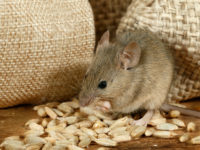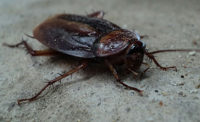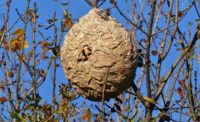Pest Control From Farm to Fork

Liudmila Chernetska/iStock/Getty Images Plus via Getty Images
We are all familiar with the phrase “farm to fork”—the concept that restaurants and consumers buy directly from local farmers. Farm to fork takes another step in the food safety concept of traceability: tracking foods from their initial location to their final destination. Pest control is integral in protecting that food from its origin to the end-user. The U.S. FDA’s Good Manufacturing Practices state that if “food has been prepared, packed, or held under insanitary conditions whereby it may have become contaminated with filth, or whereby it may have been rendered injurious to health,” then it is considered adulterated. Insanitary conditions include the presence of insects, rodents, droppings, insect parts, rodent hairs, and more.
Farm and Raw Products Concerns
No matter what the initial raw ingredient is, it comes from somewhere: a plant, an animal, or a mineral. If adequate pest control is not present at this initial stage, then the opportunity exists for pests to infiltrate a site and infest raw ingredients.
One of the tenets of pest management is to keep pests from reaching the facility and the product within it. This can be partly accomplished by making sure all incoming product is inspected. Thorough inspection of all product is easier said than done, however; there simply is not enough time to break down and inspect every single pallet that comes into the site. However, every effort should be made to conduct a visual inspection of the items and the inside of all transportation vehicles. No “extras” should be coming in with your shipments.
A checklist for pest control should encompass the following:
- Have you inspected all of your farm suppliers?
- Have you noticed any pest issues arising from shipments and, if so, have you followed up on the suspected source?
- Do your suppliers have third-party and other audits in order?
Packaging is also classified as a raw ingredient. This includes plastic, cardboard, glass, or any other packaging materials that are brought into the facility. Packaging raw materials must be produced in a facility that is pest-free, too.
Processing Considerations
Processing may be simple, such as taking a raw ingredient and packaging it in smaller quantities for end users. Or it may be more complicated, such as taking dozens (if not more) raw ingredients and combining them to make something completely different.
A hazard analysis, such as Hazard Analysis and Risk-Based Preventive Controls (HARPC) or Hazard Analysis and Critical Control Points (HAACP) should identify many of the major hazards, but does it include possible pest issues that could impact operation and products? Pest management in a processing facility is a partnership between the company (or internal team) doing the pest control and everyone else at the site. All personnel need to be on the lookout and report any issues that are observed.
A checklist for consulting with a pest control provider should include the following:
- What has the pest management provider identified as current or potential pest issues?
- Have incoming inspections, exclusion opportunities, and sanitation issues that can lead to pest problems been addressed?
- When was the staff last trained on observation practices for pest issues?
Processing sites include many areas that are not food processing regions, such as break rooms, restrooms, mechanical areas, offices, and others. Pest issues can arise in these non-food areas and spread if they are not caught early and mitigated quickly.
Storage and Transportation Issues
Even after a finished product leaves a product facility, it is still not guaranteed to be safe from pests. Many pests can chew through packaging and will take advantage of broken packages and spilled product. Even if the packaging is intact, the FDA’s definition of food adulteration requires only that the product be held in insanitary conditions. If rodents, insects, or other pests are present in the area, then the product is considered to be contaminated.
Storage sites typically have a lot more “movement,” with multiple goods coming and going to multiple locations, often 24 hours per day. Exclusion and inspections are essential at these sites to monitor for pest issues. A checklist for storage sites should include the following:
- Just like the farms from which product is sourced, have your storage sites been inspected?
- Are all of the storage sites’ audit requirements being met, and are their pest control procedures adequate?
- What other products are being stored at the site that may pose a pest risk to your products?
In large and busy warehouses, first in, first out (FIFO) procedures can be challenging. Pallets may get shifted around, and newer products can easily be placed in front of older products. If pests start appearing, check for older food products stored nearby. The longer product sits untouched, the more potential there is for pest infestation.
End-User Considerations
The last thing a food producer wants is a social media post that screams, “Look what I found in my (insert product name here)!!!” The chance of a product recall increases if pest issues are found. Unhappy customers cost more than the price of the product—lost revenue due to bad press and bad impressions is expensive.
A food producer cannot control what happens in a restaurant kitchen or an individual’s home, but it can control what happens at its site to ensure that its facility and food shipments are pest-free. It is essential to keep accurate records showing which pest prevention methods are in place and the responses that have occurred when pests have been found. This helps shift the focus to the actual source of pest infiltration.
A checklist for keeping good pest control records should include several elements:
- Are all pest control records accurate, complete, and up to date? Remember: Records are proof that pest control is being carried out successfully!
- When was the last time the pest management plan was analyzed and adjusted (if needed)?
- Has anything changed recently (construction, new suppliers, new product lines) that could impact pest concerns?
Customer complaints are a valuable source of information and can be used to trace where (and even when) an issue may have occurred. When customer complaints are received, try to get as much information as possible to investigate the problem.
Farm to fork, traceability, supply chain—regardless of the term used, pest issues can occur anywhere along the process. Talk with your pest provider or internal team about how to establish preventative practices to ensure that your products stay pest-free.
Looking for a reprint of this article?
From high-res PDFs to custom plaques, order your copy today!






